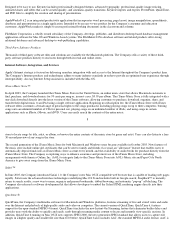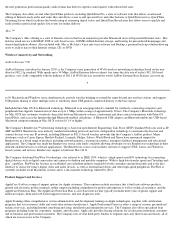Apple 2003 Annual Report Download - page 19
Download and view the complete annual report
Please find page 19 of the 2003 Apple annual report below. You can navigate through the pages in the report by either clicking on the pages listed below, or by using the keyword search tool below to find specific information within the annual report.
including reseller and end-user rebates, and other sales programs and volume-
based incentives. The estimated cost of these programs is accrued
as a reduction to revenue in the period the Company has sold the product and committed to a plan. The Company also records reductions to
revenue for expected future product returns based on the Company's historical experience. Future market conditions and product transitions
may require the Company to increase customer incentive programs and incur incremental price protection obligations that could result in
additional reductions of revenue at the time such programs are offered. Additionally, certain customer incentive programs require management
to estimate the number of customers who will actually redeem the incentive based on historical experience and the specific terms and
conditions of particular incentive programs. If a greater than estimated proportion of customers redeem such incentives, the Company would be
required to record additional reductions to revenue, which could have a material adverse impact on the Company's results of operations.
Allowance for Doubtful Accounts
The Company distributes its products through third-party resellers and directly to certain education, consumer, and commercial customers. The
Company generally does not require collateral from its customers. However, when possible the Company does attempt to limit credit risk on
trade receivables with credit insurance for certain customers in Latin America, Europe and Asia and by arranging with third-party financing
companies to provide flooring arrangements and other loan and lease programs to the Company's direct customers. These credit-financing
arrangements are directly between the third-party financing company and the end customer. As such, the Company does not assume any
recourse or credit risk sharing related to any of these arrangements. However, considerable trade receivables that are not covered by collateral,
third-party flooring arrangements, or credit insurance are outstanding with the Company's distribution and retail channel partners.
The allowance for doubtful accounts is based on management's assessment of the collectibility of specific customer accounts and includes
consideration of the credit worthiness and financial condition of those specific customers. The Company records an allowance to reduce the
specific receivables to the amount that is reasonably believed to be collectible. The Company also records an allowance for all other trade
receivables based on multiple factors including historical experience with bad debts, the general economic environment, the financial condition
of the Company's distribution channels, and the aging of such receivables. If there is a deterioration of a major customer's financial condition, if
the Company becomes aware of additional information related to the credit worthiness of a major customer, or if future actual default rates on
trade receivables in general differ from those currently anticipated, the Company may have to adjust its allowance for doubtful accounts, which
would affect earnings in the period the adjustments are made.
Inventory Valuation and Inventory Purchase Commitments
The Company must order components for its products and build inventory in advance of product shipments. The Company records a write-
down for inventories of components and products, including third-party products held for resale, which have become obsolete or are in excess
of anticipated demand or net realizable value. The Company performs a detailed review of inventory each period that considers multiple factors
including demand forecasts, product lifecycle status, product development plans, current sales levels, and component cost trends. The personal
computer industry is subject to a rapid and unpredictable pace of product and component obsolescence and demand changes. If future demand
or market conditions for the Company's products are less favorable than forecasted or if unforeseen technological changes negatively impact
the utility of component inventory, the Company may be required
21
to record additional write-downs which would negatively affect gross margins in the period when the write-downs are recorded.
The Company accrues necessary reserves for cancellation fees related to component orders that have been cancelled. Consistent with industry
practice, the Company acquires components through a combination of formal purchase orders, supplier contracts, and open orders based on
projected demand information. These commitments typically cover the Company's requirements for periods ranging from 30 to 130 days. If
there is an abrupt and substantial decline in demand for one or more of the Company's products or an unanticipated change in technological
requirements for any of the Company's products, the Company may be required to record additional reserves for cancellation fees that would
negatively affect gross margins in the period when the cancellation fees are identified.
Valuation of Long-Lived Assets Including Acquired Intangibles
The Company reviews property, plant, and equipment and certain identifiable intangible assets for impairment whenever events or changes in
circumstances indicate the carrying amount of such an asset may not be recoverable. Recoverability of these assets is measured by comparison
of their carrying amount to future undiscounted cash flows the assets are expected to generate. If such assets are considered to be impaired, the
impairment to be recognized in earnings equals the amount by which the carrying value of the assets exceeds their fair market value. Although
the Company has recognized no material impairment adjustments related to its property, plant, and equipment or identifiable intangibles during
the past three fiscal years, except those made in conjunction with restructuring actions, deterioration in the Company's business in a geographic
region or business segment in the future, including deterioration in the performance of individual retail stores, could lead to such impairment
adjustments in the future periods in which such business issues are identified.
The Company adopted Statement of Financial Accounting Standards (SFAS) No. 142, Goodwill and Other Intangible Assets , in the first
quarter of fiscal 2002. As a result, the Company no longer amortizes goodwill but instead performs a review of goodwill for impairment
























